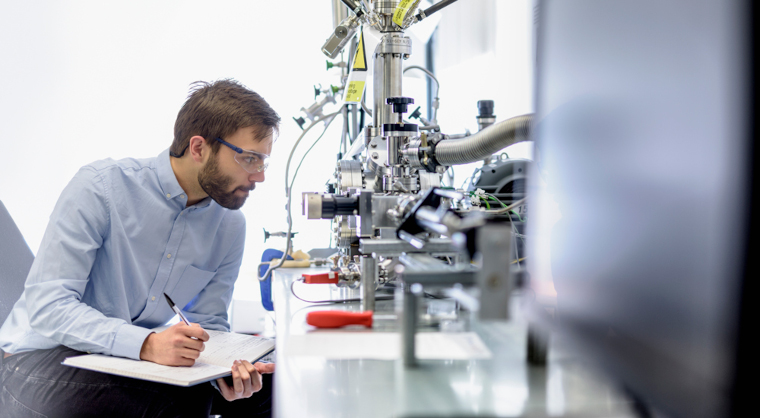The Materials Research Facility equipment and support
UKAEA’s Materials Research Facility (MRF) prepares and examines samples of radioactive materials to assess their performance in nuclear reactors.
UKAEA’s Materials Research Facility (MRF) prepares and examines samples of radioactive materials to assess their performance in nuclear reactors.
The facility at Culham Campus near Oxford is available for users working in fission, fusion and other research programmes. It is part of the UK Government’s National Nuclear User Facility and the Henry Royce Institute for Advanced Materials.
The Materials Research Facility has hot cells for processing neutron-irradiated samples and equipment for characterising them. It bridges the gap between the university or industrial laboratory and large facilities at nuclear licensed sites, with affordable, convenient access.

Overview
We can cut, polish and encapsulate individual Charpy-style samples up to the TeraBecquerel level for analysis either on-site or back at your institute.
There is also a workshop and an experimental area for tritium, beryllium and other hazardous materials.
Experienced staff from UKAEA operate the MRF and provide users with support in sample preparation and analysis, as well as logistics advice for the transport of materials.
Operations
The Materials Research Facility has a scientific team and operational team to support experiments and sample preparation.
The recipe and methods for sample preparation and examination are determined together with the customer to provide result-driven support. Non-active sample preparation and testing can be performed as trials (to determine the methodology) or for comparison against the irradiated materials. The active sample preparation will be performed by the operational team in the controlled area. After sample preparation, the sample will be loaded in the scientific instrument and handed over to the scientific team in the control room to perform the scientific evaluation.
All work on active samples will be executed in shielded facilities by the operational team. If customers want to perform the scientific examination themselves, the scientific team will provide equipment specific training and give support when required.
Sample preparation
Our sample preparation equipment includes:
- Hot-cell sample processing for active materials
- Glovebox sample preparation for low-active materials
- Sample processing for non-active materials
- Precision Ion-beam Polishing System
- Sputter Coater
- Lab-scale Electro Discharge Machining for non-active materials (in development)
- TEM discs preparation techniques
- Hot-cell Lab-scale Electro Discharge Machining for active materials (in development)
- Vacuum Furnace
Microstructural analysis
Our microstructural analysis equipment includes:
- Scanning Electron Microscope (with EDS, EBSD, TKD, WDS)
- FEI Helios NanoLab 600i Focussed Ion Beam
- TESCAN AMBER X Plasma Focussed Ion Beam Scanning Electron Microscope
- WITec Alpha 300 ARS Confocal Raman Spectroscopy
- Atom Force Microscope
- X-ray Diffractometer
- Positive Materials Identification X-ray Fluorescence Spectroscopy
- Gamma Spectroscopy for radiological finger printing
- Jeol Neoarm Scanning Transmission Electron Microscope
Mechanical testing
Our mechanical testing equipment includes:
- Nanoindentation
- Instrumented indentation
- Small scale mechanical load frame (5 kN)
- Load frame for static tests (10 kN)
- Load frame for dynamic tests (15 kN) (under development)
- Ultrasonic Fatigue Rig (under development)
- Impulse Excitation Technique
- Environmental chambers for high temperature testing (under development)
- Hot-cell mechanical testing for active materials (under development)
- Digital Image Correlation setup (under development)
Thermo-physical characterisation
Our thermo-physical characterisation equipment includes:
- Laserflash Analyser (under development)
- Dilatometry
- Simultaneous Thermogravimetrical Analyser (under development)
- Gas pycnometry
- Thermal Desorption Spectroscopy
- Physical Properties Measurement System
- Netzch Differential Scanning Calorimeter (under development)
Using the equipment
We would be happy to talk to you about the Materials Research Facility at Culham and whether it is suitable for your work. Academic staff should always contact us before submitting grant applications that seek funds for use of the MRF.
Most scientific equipment can be operated remotely from the MRF control room by users after training. The training will allow the user to operate the equipment safely and focus on the science that needs to be done. A driving test to test if the user is allowed to use the instrument(s) independently will be part of the training. Support from an MRF user will be available.
Research partnerships
The Henry Royce Institute has funding to support programmes that involve Royce-funded equipment and training of younger researchers in its use. We can advise on whether this could be an option for your research.
UKAEA uses the MRF as part of its fusion research programme and may be interested in working with scientists doing related research.
Bespoke solutions
We can advise you on the transport and handling of radioactive material.
We don’t give indicative prices on this website, as they depend greatly on the work to be carried out. Factors include the type of material, its activity and associated costs (for example, for radioactive waste disposal), the amount of hot cell work involved, and which scientific instruments are used.